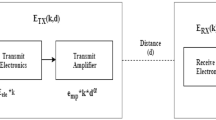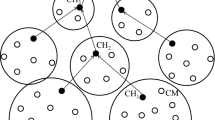Abstract
Sensor nodes (SNs) in wireless sensor networks (WSNs) sense surrounding environmental data and transfers it to the end user via multi-hop transmission which results in inflated energy expenditure. Thus, the main motive for design and deployment of a WSN is to balance the energy consumption and, thereby maximize its network lifetime. An effective topology control scheme which helps in achieving this objective is clustering of SNs and at the same time selecting appropriate cluster heads (CHs). In this paper, we propose Fuzzy Logic-based Energy Adequate Clustering (FLEAC), a clustering protocol that makes use of fuzzy if–then rules for selecting appropriate CHs on the basis of five fuzzy descriptors, namely residual energy, average intra-cluster distance, compaction degree, packet drop probability and node history. Moreover, the proposed protocol considers selection of relay nodes (RNs) for alleviating excessive energy consumption of cluster heads. Improved grasshopper optimization algorithm is employed for the selection of appropriate relay nodes. The CHs collect data and send to the RNs that relays them to the Base station (BS). These RNs share the CHs data transmission and, thereby offload the CHs energy consumption. The performance of the proposed protocol is compared with existing comparative protocols by varying several parameters such as position of the BS and network size. The simulation results show that the proposed protocol outperforms other comparative protocols in the considered scenarios by achieving well balanced energy consumption and enhanced network lifetime.
















Similar content being viewed by others
Availability of Data and Material
The datasets generated during and/or analysed during the current study are available from the corresponding author on reasonable request.
Code Availability
The codes can be made available from the corresponding author on reasonable request.
References
Ehsan, S., & Hamdaoui, B. (2012). A survey on energy-efficient routing techniques with QoS assurances for wireless multimedia sensor networks. IEEE Communications Surveys & Tutorials, 14(2), 265–278.
Elhabyan, R., Shi, W., & St-Hilaire, M. (2019). Coverage protocols for wireless sensor networks: Review and future directions. Journal of Communications and Networks, 21(1), 45–60.
Liu, X. (2015). Atypical hierarchical routing protocols for wireless sensor networks: A review. IEEE Sensors Journal, 15(10), 5372–5383.
Shahraki, A., Taherkordi, A., Haugen, O., & Eliassen, F. (2021). A survey and future directions on clustering: From WSNS to IOT and modern networking paradigms. IEEE Transactions on Network and Service Management, 18(2), 2242–2274.
Al-Mousawi, A. J. (2019). Evolutionary intelligence in wireless sensor network: Routing, clustering, localization and coverage. Wireless Networks, 26, 5595–5621.
Bhushan, B., & Sahoo, G. (2018). Routing protocols in wireless sensor networks. In B. Mishra, S. Dehuri, B. Panigrahi, A. Nayak, B. Mishra, & H. Das (Eds.), Computational intelligence in sensor networks studies in computational intelligence (pp. 215–248). Springer.
Kumar, S. A. A., Ovsthus, K., & Kristensen, L. M. (2014). An industrial perspective on wireless sensor networks—A survey of requirements, protocols, and challenges. IEEE Communications Surveys & Tutorials, 16(3), 1391–1412.
Albukhary, R. A., & Bouabdallah, F. (2019). Time-variant balanced routing strategy for underwater wireless sensor networks. Wireless Networks, 25, 3481–3495.
Bhushan, B., & Sahoo, G. (2019). \(E^{2} SR^{2}\) E 2 S R 2: An acknowledgement-based mobile sink routing protocol with rechargeable sensors for wireless sensor networks. Wireless Networks, 25(5), 2697–2721.
Tomic, I., & Mccann, J. A. (2017). A survey of potential security issues in existing wireless sensor network protocols. IEEE Internet of Things Journal, 4(6), 1910–1923.
Guleria, K., & Verma, A. K. (2018). Comprehensive review for energy efficient hierarchical routing protocols on wireless sensor networks. Wireless Networks, 25(3), 1159–1183.
Liu, F., & Chang, Y. (2019). An energy aware adaptive kernel density estimation approach to unequal clustering in wireless sensor networks. IEEE Access, 7, 40569–40580.
Song, X., Wen, T., Sun, W., Zhang, D., Guo, Q., & Zhang, Q. (2016). A coverage-aware unequal clustering protocol with load separation for ambient assisted Living based on wireless sensor networks. China Communications, 13(5), 47–55.
Zhang, J., Feng, X., & Liu, Z. (2018). A grid-based clustering algorithm via load analysis for industrial internet of things. IEEE Access, 6, 13117–13128.
Saremi, S., Mirjalili, S., & Lewis, A. (2017). Grasshopper optimisation algorithm: Theory and application. Advances in Engineering Software, 105, 30–47.
Jitkongchuen, D., & Ampant, U. (2018). Integrated optimization of differential evolution with grasshopper optimization algorithm. Journal of Robotics, Networking and Artificial Life, 5(3), 165.
Heinzelman, W., Chandrakasan, A., & Balakrishnan, H. (2002). An application-specific protocol architecture for wireless microsensor networks. IEEE Transactions on Wireless Communications, 1(4), 660–670.
Qin, Y., Tang, Q., Liang, Y., Yue, X., & Li, X. (2011). An energy-efficient cooperative MIMO scheme for wireless sensor networks based on clustering. In: 2011 14th IEEE International conference on computational science and engineering.
Xu, D., & Gao, J. (2011). Comparison study to hierarchical routing protocols in wireless sensor networks. Procedia Environmental Sciences, 10, 595–600.
Younis, O., & Fahmy, S. (2004). HEED: A hybrid, energy-efficient, distributed clustering approach for ad hoc sensor networks. IEEE Transactions on Mobile Computing, 3(4), 366–379.
Lindsey, S., & Raghavendra, C. (2002). PEGASIS: Power-efficient gathering in sensor information systems. In: Proceedings, IEEE Aerospace conference, pp 1–3.
Yu, J., Qi, Y., Wang, G., Guo, Q., & Gu, X. (2011). An energy-aware distributed unequal clustering protocol for wireless sensor networks. International Journal of Distributed Sensor Networks, 7(1), 202145.
Dahnil, D., Ho, C., & Singh, Y. (2012). Topology-controlled adaptive clustering for uniformity and increased lifetime in wireless sensor networks. IET Wireless Sensor Systems, 2(4), 318–327.
Nayak, B. K., Mishra, M., Rai, S. C., & Pradhan, S. K. (2014). A novel cluster head selection method for energy efficient wireless sensor network. International Conference on Information Technology, 2014, 53–57.
Yu, J., Feng, L., Jia, L., Gu, X., & Yu, D. (2014). A local energy consumption prediction-based clustering protocol for wireless sensor networks. Sensors, 14(12), 23017–23040.
Tarhani, M., Kavian, Y. S., & Siavoshi, S. (2014). SEECH: Scalable energy efficient clustering hierarchy protocol in wireless sensor networks. IEEE Sensors Journal, 14(11), 3944–3954.
J. Kim, S. Park, Y. Han and T. Chung, CHEF: Cluster head election mechanism using fuzzy logic in wireless sensor networks. In: 2008 10th International conference on advanced communication technology, 2008, pp. 654–659.
Bagci, H., & Yazici, A. (2010). An energy aware fuzzy unequal clustering algorithm for wireless sensor networks. International Conference on Fuzzy Systems. https://doi.org/10.1109/FUZZY.2010.5584580
Sert, S. A., Bagci, H., & Yazici, A. (2015). MOFCA: Multi-objective fuzzy clustering algorithm for wireless sensor networks. Applied Soft Computing, 30, 151–165.
Siqing, Z., Yang, T., & Feiyue, Y. (2018). Fuzzy logic-based clustering algorithm for multi-hop wireless sensor networks. Procedia Computer Science, 131, 1095–1103.
Wang, Q., Lin, D., Yang, P., & Zhang, Z. (2018). A fuzzy-logic based energy-efficient clustering algorithm for the wireless sensor networks. In: 2018 26th International Conference on Software, Telecommunications and Computer Networks (SoftCOM), pp 1–6.
Sert, S. A., Alchihabi, A., & Yazici, A. (2018). A two-tier distributed fuzzy logic-based protocol for efficient data aggregation in multihop wireless sensor networks. IEEE Transactions on Fuzzy Systems, 26(6), 3615–3629.
Verma, A., Kumar, S., Gautam, P. R., Rashid, T., & Kumar, A. (2020). Fuzzy logic based effective clustering of homogeneous wireless sensor networks for Mobile Sink. IEEE Sensors Journal, 20(10), 5615–5623.
Lata, S., Mehfuz, S., Urooj, S., & Alrowais, F. (2020). Fuzzy clustering algorithm for enhancing reliability and network lifetime of wireless sensor networks. IEEE Access, 8, 66013–66024.
Adnan, M., Yang, L., Ahmad, T., & Tao, Y. (2021). An unequally clustered Multi-hop routing protocol based on fuzzy logic for wireless sensor networks. IEEE Access, 9, 38531–38545.
Chen, Q., Kanhere, S. S., & Hassan, M. (2009). Analysis of per-node traffic load in multi-hop wireless sensor networks. IEEE Transactions on Wireless Communications, 8(2), 958–967.
Wang, J., Cao, J., Li, B., Lee, S., & Sherratt, R. S. (2015). Bio-inspired ant colony optimization-based clustering algorithm with mobile sinks for applications in consumer home automation networks. IEEE Transactions on Consumer Electronics, 61(4), 438–444.
Mo, Y., Wang, B., Liu, W., & Yang, L. T. (2013). A sink-oriented layered clustering protocol for wireless sensor networks. Mobile Networks and Applications, 18(5), 639–650.
Handy, M., Haase, M., & Timmermann, D. (2002). Low energy adaptive clustering hierarchy with deterministic cluster-head selection. In: 4th International workshop on mobile and wireless communications network, pp. 368–372.
Mamdani, E., & Assilian, S. (1975). An experiment in linguistic synthesis with a fuzzy logic controller. International Journal of Man-Machine Studies, 7(1), 1–13.
Mohamad, I. B., & Usman, D. (2013). Standardization and its effects on k-means clustering algorithm. Research Journal of Applied Sciences, Engineering and Technology, 6(17), 3299–3303.
Grus, J. (2015). Data science from scratch: First principles with python. O’Reilly Media Inc.
Ioffe, S.; Szegedy, C. Batch normalization: Accelerating deep network training by reducing internal covariate shift. arXiv:1502.03167 2015.
Abo-Zahhad, M., Ahmed, S. M., Sabor, N., & Sasaki, S. (2015). Mobile sink-based adaptive immune energy-efficient clustering protocol for improving the lifetime and stability period of wireless sensor networks. IEEE Sensors Journal, 15(8), 4576–4586.
Sadollah, A., Bahreininejad, A., Eskandar, H., & Hamdi, M. (2012). Mine blast algorithm for optimization of truss structures with discrete variables. Computers & Structures, 102–103, 49–63.
Rashedi, E., Nezamabadi-Pour, H., & Saryazdi, S. (2009). GSA: A gravitational search algorithm. Information Sciences, 179(13), 2232–2248.
Cuevas E., Díaz Cortés M. A., Oliva Navarro D. A. (2016). Optimization based on the behavior of locust swarms. In Advances of Evolutionary Computation: Methods and Operators. Studies in Computational Intelligence (vol. 629, pp. 101-120). Cham: Springer. https://doi.org/10.1007/978-3-319-28503-0_6.
Gu, H., & Xu, L. (2011). Perceptive particle swarm optimization algorithm for constrained optimization problems. Journal of Computer Applications, 31(1), 85–88.
Funding
This work did not receive any grant from funding agencies in the public, commercial, or not-for-profit sectors.
Author information
Authors and Affiliations
Corresponding author
Ethics declarations
Conflict of interest
The authors declare that they have no conflict of interest.
Human and Animal Rights
This article does not contain any studies with animals performed by any of the authors.
Additional information
Publisher's Note
Springer Nature remains neutral with regard to jurisdictional claims in published maps and institutional affiliations.
Rights and permissions
About this article
Cite this article
Bhushan, B., Sahoo, G. FLEAC: Fuzzy Logic-based Energy Adequate Clustering Protocol for Wireless Sensor Networks using Improved Grasshopper Optimization Algorithm. Wireless Pers Commun 124, 573–606 (2022). https://doi.org/10.1007/s11277-021-09373-4
Accepted:
Published:
Issue Date:
DOI: https://doi.org/10.1007/s11277-021-09373-4




